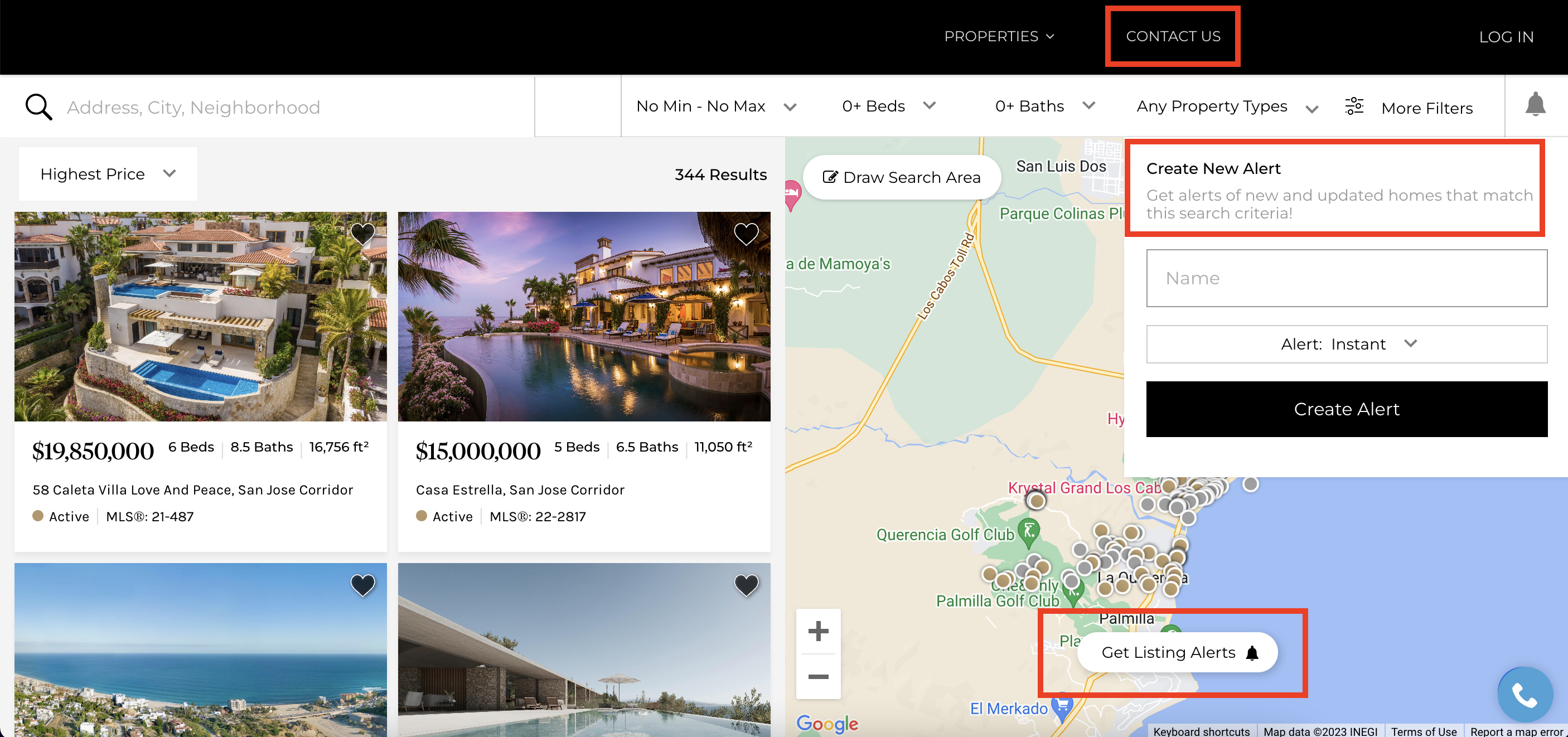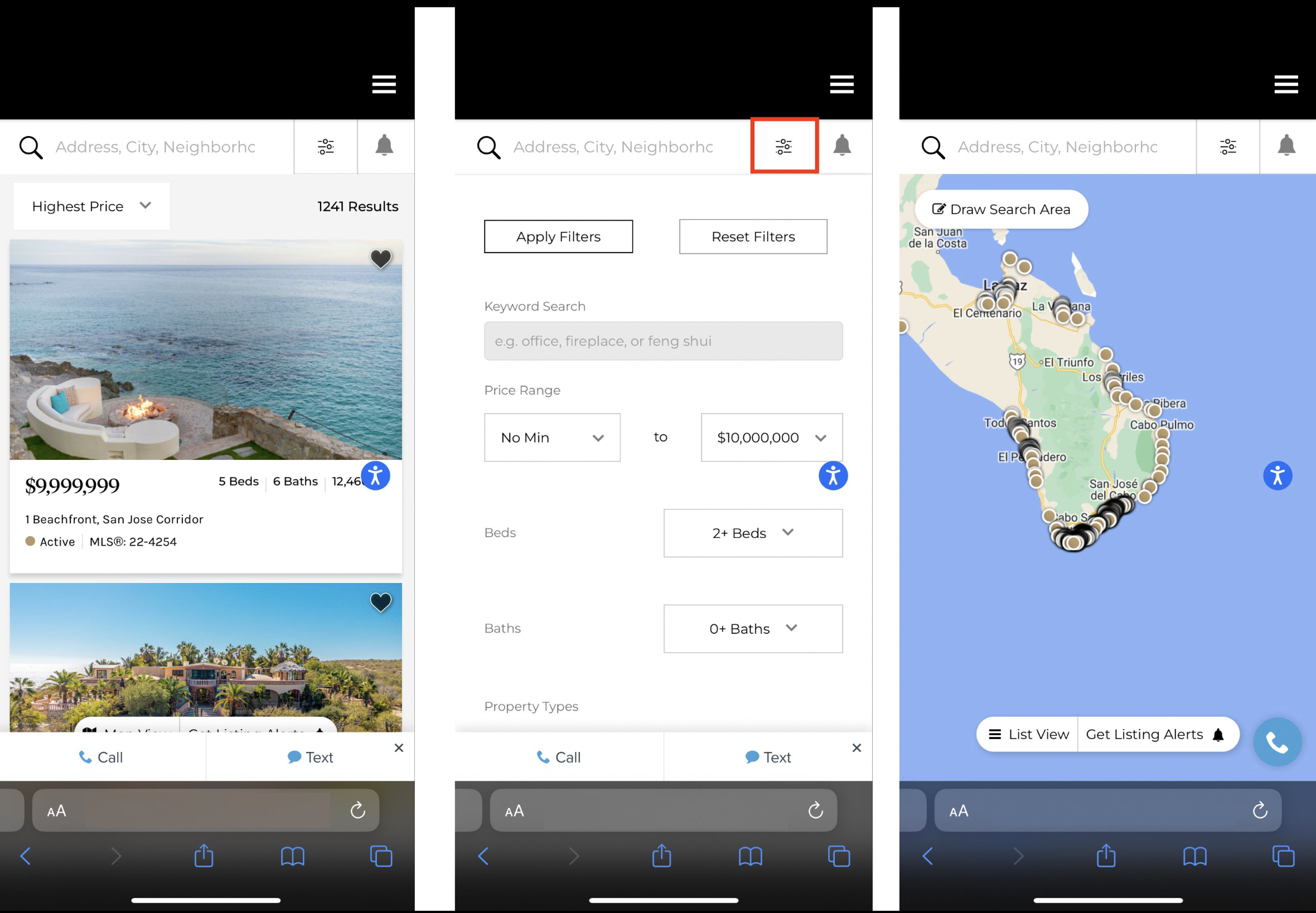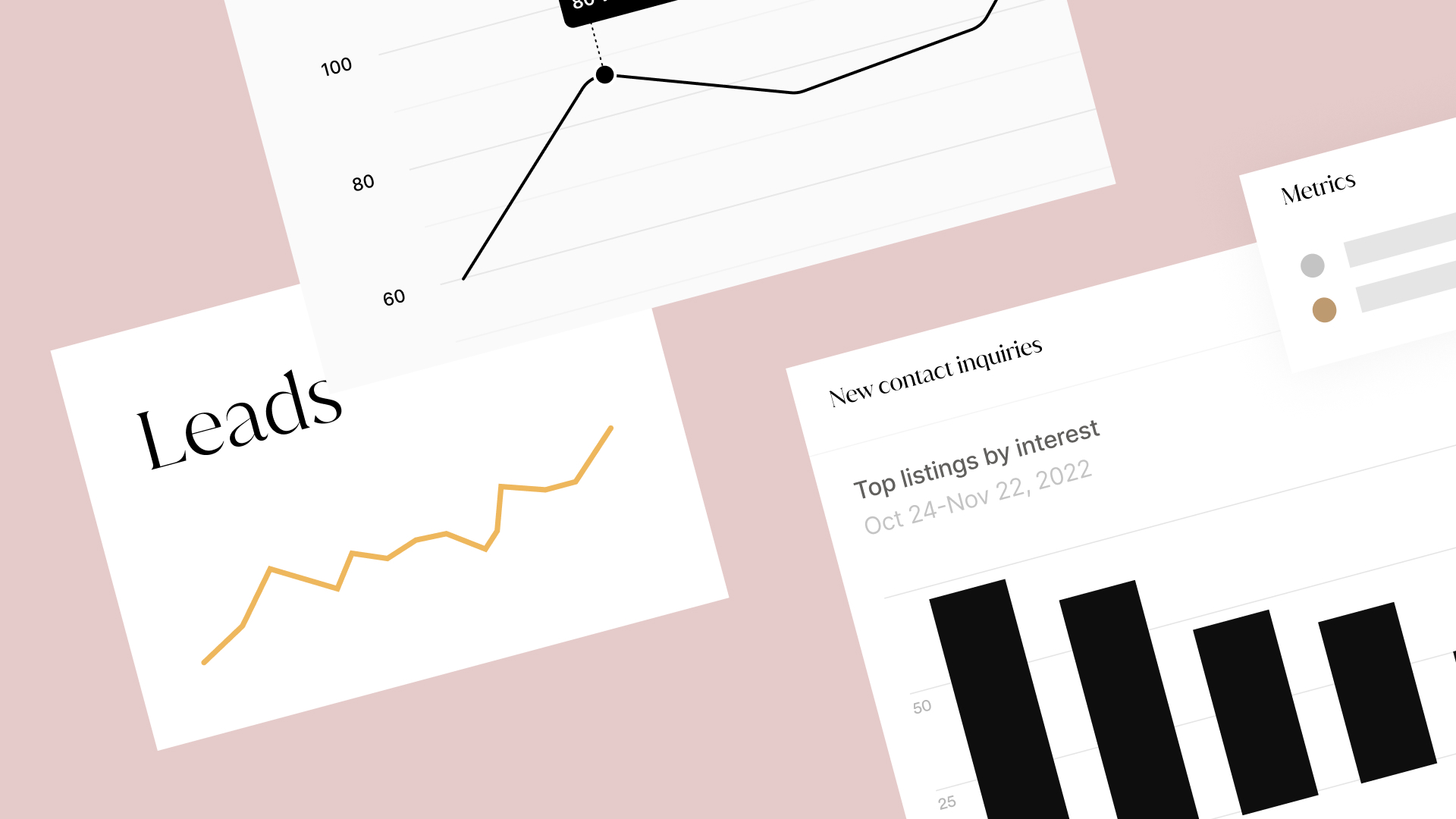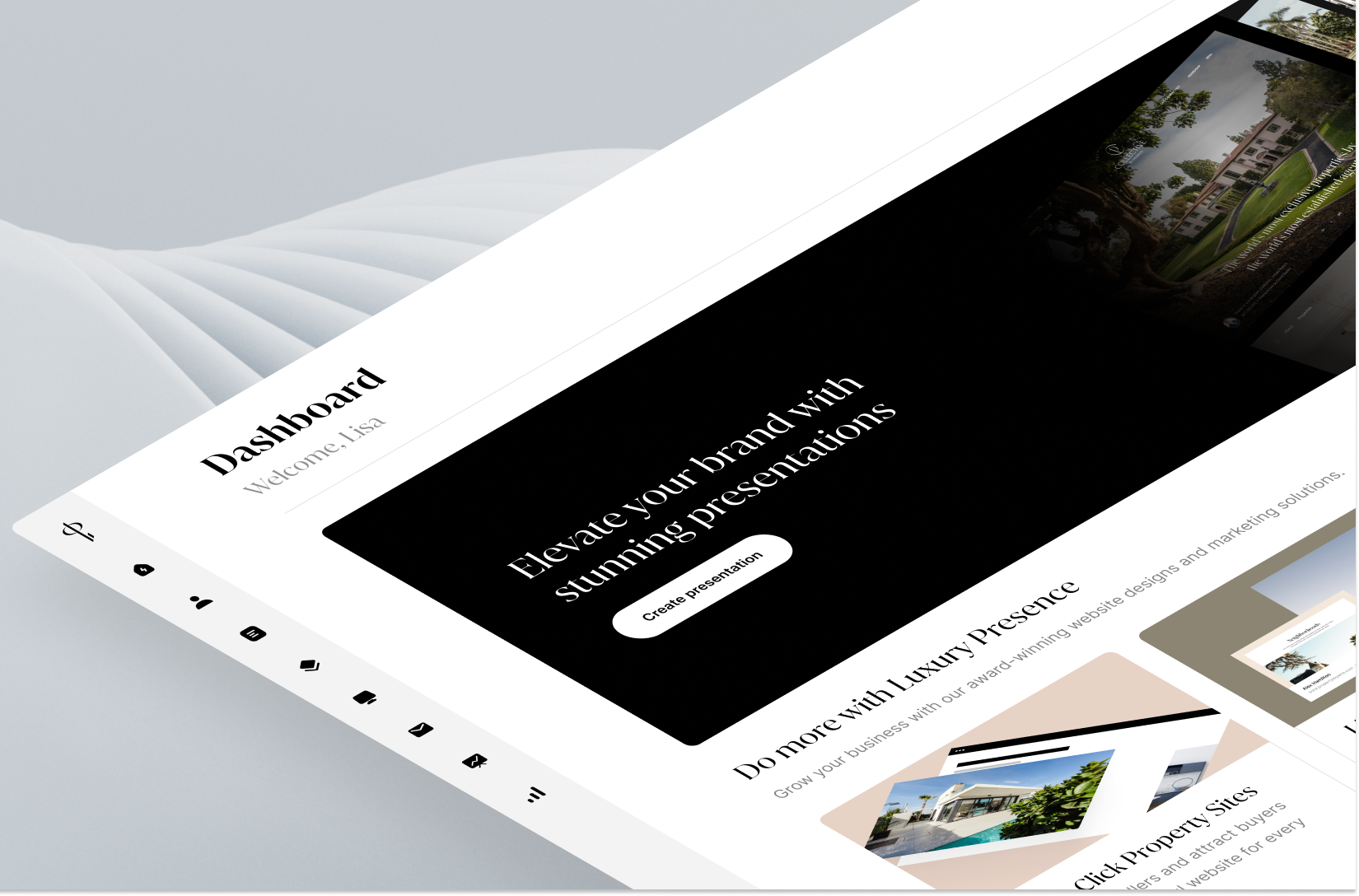In today’s digital landscape, landing pages are essential to the success of any marketing campaign. If you want to generate more high-quality leads, your landing pages need to be optimized to convert your site’s visitors into contacts.
While most real estate websites see landing page conversion rates between 2% and 5%, our clients consistently experience superior results. One Los Cabos-based team even gets an impressive 8.42% conversion rate.
Curious about our methods? Schedule a demo with Luxury Presence to unlock your website’s potential. Or read on to discover the secrets behind our success in Baja specifically.
Find It Fast
Why real estate landing page conversion rates matter
Before we dive into the tactics we use to drive stellar results for our clients, here’s a quick overview of the key elements of fully optimized landing pages and how they contribute to a successful lead generation strategy.
- Lead capture: Landing pages provide a platform to capture leads by collecting contact information from visitors, often in exchange for valuable content or real estate listings.
- Targeted messaging: Each landing page can be customized for a specific audience, allowing you to tailor your messaging to resonate with potential leads’ interests and needs.
- Driving action: A well-designed landing page guides visitors toward a clear call to action (CTA). This is often expressed in button language such as “contact us,” “book a viewing,” or “download our neighborhood guide.”
- PPC campaign integration: Pay-per-click (PPC) campaigns often direct traffic to landing pages. A well-designed landing page can increase the conversion rate of these campaigns, resulting in a reduced cost per lead.
- Demonstrating expertise: Landing pages provide a platform to showcase valuable content such as e-books, newsletters, or blog articles related to the real estate industry. This can attract visitors, build credibility, and establish you as an expert.
- Improved user experience: By focusing on a single objective and providing clear, concise information, landing pages can improve the user experience, which builds trust and encourages visitors to convert into leads.
- Data analysis: With landing pages, you can track visitor behavior, evaluate the effectiveness of your marketing efforts, and make data-driven decisions to improve your campaigns.
When your landing page is finely tuned for high conversion rates, the rewards are significant. Meticulously optimized landing pages attract more highly qualified leads, resulting in greater transaction volume and greater cost savings in customer acquisition. By achieving higher conversion rates, you streamline expenses associated with acquiring new customers.
How we maximize a landing page conversion rate
Our outsized lead conversion rates on landing pages are by design. We specialize in building quality campaigns that are strategically optimized from the start. Because we’re passionate about helping real estate professionals succeed, we’re sharing our secret sauce below. You can follow these steps to replicate our clients’ success or book a demo today to call in the experts.
1. Create a PPC ad campaign to drive traffic
The first step is to establish a PPC ad campaign through Google. Google’s advanced algorithms and sophisticated predictive analytics make it possible to segment highly targeted leads. Ads appear in your ideal lead’s search results based on demographics, geography, and other factors. When the lead clicks on the ad, Google sends them directly to a landing page you’ve specifically designed and optimized for conversion.
How we did it in Baja:
We implemented a Google PPC campaign for our Los Cabos-based luxury client. Through our ads, we drove traffic directly to landing pages featuring an MLS search of Los Cabos homes—exactly what the buyer leads were looking for.

2. Deliver relevant landing page content
Next, give your audience what you promised. Make sure everything that appears on your landing page is perfectly aligned with what visitors saw in the ad. If you’re advertising Los Cabos homes for sale and the ad directs your lead to your “about me” page, your lead is not getting what they need or want. Your ad money is wasted and your lead may feel duped.
How we did it in Baja:
The ad campaign for our Los Cabos client offered luxury homes listings. When the lead clicked on the ad, it took them to a landing page that we populated with the latest listings specific to Los Cabos. The leads got what they were looking for, which provided a great user experience and went a long way in establishing trust.
3. Use clear CTAs
A call to action (CTA) serves as the guiding beacon for landing page visitors, directing them to do what you want them to. It provides clarity and purpose to their online journey, whether the action is signing up for a newsletter or booking an appointment.
Without a well-crafted CTA, visitors may feel adrift and unsure of what steps to take next, leading to missed opportunities for engagement and conversion. A strategically placed and compelling CTA not only prompts action but also reinforces the value proposition of the website’s offerings. It acts as a pivotal tool in driving conversions and achieving business objectives, effectively turning passive browsers into active participants in the online experience.
How we did it in Baja:
Knowing that a thoughtfully designed CTA empowers users, we decided to offer several routes toward meaningful interactions and fulfillment of their needs. We put the most important CTAs for our Los Cabos clients at optimal positions on the page. These included “get listing alerts” and “contact us.” This made it easy for leads to find what they were looking for and take the next step in their online journey.

4. Optimize for mobile
Many visitors access your landing page via mobile devices, so they must be fully optimized for viewing on smartphones and tablets. Prioritizing the mobile experience maximizes reach and engagement potential.
Here are the crucial components for mobile users:
- Responsive design: Each feature and tool must automatically adjust its layout, images, and functionality to fit the screen size of the device being used.
- Touch-friendly navigation: Users need to be able to easily tap links and other interactive elements with a finger, with enough spacing to prevent accidental clicks.
- Easy-to-use tools: If your landing page includes filters for search parameters (such as location, property type, and price), ensure they are intuitive and easy to use on a smaller screen.
- Optimized visual content: Make sure your images strike the right balance between quality and fast loading times.
- Clear calls to action: Make sure all buttons are prominent, clear, and easy to tap on a small screen.
- Map integration: Interactive maps with property locations should be ease to use and bug-free. A pinch-and-zoom type functionality is ideal.
- Click-to-call functionality: Consider adding a click-to-call button that allows users who are already browsing on their phones to contact an agent directly.
- Push notifications: Allow users to opt in to receive mobile notifications about new listings or changes to their saved properties.
How we did it in Baja:
Knowing that 73% of homebuyers search for properties using tablets or smartphones, we fully optimized our Los Cabos client’s landing pages for mobile. When a lead clicked on an ad and ended up on an MLS search, they had a seamless experience regardless of their chosen device. They could easily filter results, zoom in on map results, and set up notifications for new results to their search.

5. Prioritize user experience and design
A quality user experience (UX) fosters trust and credibility through intuitive navigation, clear messaging, and visually appealing design. Landing pages that are designed with UX in mind are more likely to capture and retain visitor interest.
Solid UX contributes to brand differentiation and long-term customer relationships. By consistently delivering an exceptional experience, agents distinguish themselves from competitors and build loyalty among clients and prospects.
How we did it in Baja:
Our designers understand that UX in landing page design is not merely a matter of aesthetics but a strategic imperative when attracting, engaging, and converting leads effectively in today’s digital landscape. We kept user experience top of mind when designing the landing page, ensuring it was easy to navigate and visually appealing, and that the search tool was simple and intuitive.
6. Display personalized content
Personalizing content on real estate landing pages fosters meaningful connections with potential clients, encourages further exploration, and maximizes conversion rates. By tailoring content to match the specific needs, preferences, and demographics of individual visitors, agents can create a more engaging and relevant user experience.
Presenting relevant listings, neighborhood information, or targeted promotions addresses the visitor’s specific motivations and aspirations, ultimately keeping them engaged and moving through the conversion funnel. Plus, personalized content leads to higher conversion rates by aligning the messaging with the visitor’s stage in the buying or selling process.
How we did it in Baja:
We tailored the landing page content to the audience based on the ad or keyword that the visitor clicked on. For example, while our client’s business reaches beyond the specific Los Cabos region, we kept this landing page focused on exactly what the ads promised: luxury listings available specifically in Los Cabos.
7. Retarget leads
Retargeting is particularly helpful in increasing landing page conversion rates. This strategy is designed to reignite interest among potential clients who’ve previously engaged with the website but not converted. By deploying personalized ads across multiple digital platforms, agents can gently remind visitors of properties they’ve viewed or services they’ve considered, nudging them back to the landing page for further exploration.
How we did it in Baja:
We used retargeting to address lingering doubts or objections that may have hindered initial conversion. Through targeted messaging and showcasing testimonials and unique selling points, we assuaged concerns and provided additional incentives for prospects to re-engage with the landing page.
8. Monitor, evaluate, and measure performance
The process of enhancing landing page conversion rates takes time and resources. It’s crucial to track activity, assess progress, and measure results to ensure positive ROI. While there are plenty of resources out there for tracking performance, here are some tools we find useful:
- Google Analytics allows us to track a wide range of metrics, including user behavior, traffic sources, bounce rate, time on site, and more.
- We use Google Ads (formerly AdWords) to run ads, but it also provides detailed insights into ad performance, click-through rates, cost per click, and conversions.
- Google’s conversion tracking tool identifies how effectively our ad clicks lead to valuable customer activity, such as contact form submissions, phone calls, app downloads, newsletter sign-ups, and more.
- We add UTM tags to links so we can track where traffic is coming from and accurately measure a campaign’s success.
- We built our Presence Platform dashboard specifically to help our website clients understand the sources and campaigns behind each individual lead.
How we did it in Baja:
We set up systems to track conversions in Google Ads, so we could see exactly what was working and what wasn’t and adjust our strategies accordingly. We kept constant tabs on bounce rates, click-through rates, costs per click, page views, the ratio of return and new visitors, time on page, and the big one: conversion rates. We never stop testing and optimizing because it’s the only way to know what works best for our client’s target audience.
Hitting an 8.24% conversion rate for this all-star Los-Cabos-based team was the result of careful strategy, constant assessment, and a comprehensive plan for success.
Maximize your landing page conversion rates + Luxury Presence
Landing pages serve as pivotal gateways for converting visitors into leads. Luxury Presence’s proven expertise ensures impactful results through meticulously crafted campaigns. If you’re ready to streamline your process, attract high-quality leads, and optimize conversions, we’d love to talk. Schedule a demo with our expert team today.




